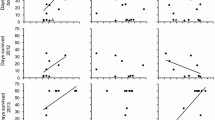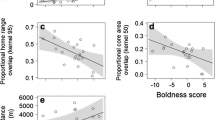Abstract
Most examples of adaptation to the urban environment relate to plasticity processes rather than to natural selection. Personality, however, defined as consistent individual differences in behaviour related to exploration, caution, and neophobia, is a good behavioural candidate character to study natural selection in relation to the urban habitat due to its heritable variation. The aim of this paper was to analyse variation in personality by comparing urban and forest great tits Parus major using standard tests of exploratory behaviour and boldness. We studied personality in 130 wild great tits captured in Barcelona city and nearby forests and found that urban birds were more explorative and bolder towards a novel object than forest birds. Genotype frequencies of the DRD4 SNP830 polymorphism, a gene region often associated with personality variation, varied significantly between forest and urban birds. Behavioural scores, however, were not correlated with this polymorphism in our population. Exploration scores correlated to boldness for forest birds but not for urban birds. Our findings suggest that the novel selection pressures of the urban environment favour the decoupling of behavioural traits that commonly form behavioural syndromes in the wild.



Similar content being viewed by others
References
Adams CE, Lindsey KJ, Ash SJ (2006) Urban wildlife management. CRC, New York
Balen JHV (1967) The significance of variations in body weight and wing length in the Great Tit, Parus major. Ardea 55:1–59
Bell AM (2005) Behavioural differences between individuals and two populations of stickleback (Gasterosteus aculeatus). J Evolut Biol 18:464–473
Bell AM, Sih A (2007) Exposure to predation generates personality in threespined sticklebacks (Gasterosteus aculeatus). Ecol Lett 10:828–834
Björklund M, Ruiz I, Senar JC (2010) Genetic differentiation in the urban habitat: the great tits (Parus major) of the parks of Barcelona city. Biol J Linn Soc 99:9–19
Bókony V, Kulcsár A, Tóth Z, Liker A (2012) Personality traits and behavioral syndromes in differently urbanized populations of house sparrows (Passer domesticus). PLoS One 7:e36639
Brown C (2012) Experience and learning in changing environments. In: Candolin U, Wong BBM (eds) Behavioural responses to a changing world: mechanisms and consequences. Oxford University Press, Oxford, pp 46–60
Budaev SV (1997) The statistical analysis of behavioural latency measures. ISCP Newslett 14:1–4
Carere C, Drent PJ, Privitera L, Koolhaas JM, Groothuis TGG (2005) Personalities in great tits, Parus major: stability and consistency. Anim Behav 70:795–805
Cole EF, Quinn JL (2012) Personality and problem-solving performance explain competitive ability in the wild. Proc R Soc B Biol Sci 279:1168–1175
Cole EF, Cram DL, Quinn JL (2011) Individual variation in spontaneous problem-solving performance among wild great tits. Anim Behav 81:491–498
Development Core Team R (2011) R: a language and environment for statistical computing. R Foundation for Statistical Computing, Vienna
Dingemanse NJ, Réale D (2005) Natural selection and animal personality. Behaviour 142:1159–1184
Dingemanse NJ, Both C, Drent PJ, Van Oers K, Van Noordwijk AJ (2002) Repeatability and heritability of exploratory behaviour in great tits from the wild. Anim Behav 64:929–938
Dingemanse NJ, Both C, Van Noordwijk AJ, Rutten AJ, Drent PJ (2003) Natal dispersal and personalities in great tits (Parus major). Proc R Soc Lond B 270:741–747
Drent PJ, Van Oers K, Van Noordwijk AJ (2003) Realized heritability of personalities in the great tit (Parus major). Proc R Soc Lond B 270:45–51
Evans KL (2010) Individual species and urbanisation. In: Gaston KJ (ed) Urban ecology. Cambridge University Press, Cambridge, pp 53–87
Evans KL, Gaston KJ, Sharp SP, McGowan A, Hatchwell BJ (2009) The effect of urbanisation on avian morphology and latitudinal gradients in body size. Oikos 118:251–259
Evans J, Boudreau K, Hyman J (2010a) Behavioural syndromes in urban and rural populations of song sparrows. Ethology 116:588–595
Evans KL, Hatchwell BJ, Parnell M, Gaston KJ (2010b) A conceptual framework for the colonisation of urban areas: the blackbird Turdus merula as a case study. Biol Rev 85:643–667
Fidler AE, van Oers K, Drent PJ, Kuhn S, Mueller JC, Kempenaers B (2007) Drd4 gene polymorphisms are associated with personality variation in a passerine bird. Proc R Soc Lond B 274:1685–1691
Finke MD (2002) Complete nutrient composition of commercially raised invertebrates used as food for insectivores. Zoo Biol 21:269–285
Garroway CJ, Sheldon BC (2013) Urban behavioural adaptation. Mol Ecol 22:3430–3432
Gaston KJ (2010) Urban ecology. Cambridge University Press, Cambridge
Hahs AK, Evans KL (2015) Expanding fundamental ecological knowledge by studying urban ecosystems. Funct Ecol 29:863–867
Hasegawa M, Ligon RA, Giraudeau M, Watanabe M, McGraw KJ (2014) Urban and colorful male house finches are less aggressive. Behav Ecol 25:641–649
Jenni L, Winkler R (1994) Moult and ageing of European Passerines. Academic, London
Karlsson Green K, Eroukhmanoff F, Harris S, Pettersson LB, Svensson EI (2016) Rapid changes in genetic architecture of behavioural syndromes following colonization of a novel environment. J Evolut Biol 29:144–152
Korsten P, Mueller JC, Hermannstadter C, Bouwman KM, Dingemanse NJ, Drent PJ, Liedvogel M, Matthysen E, Van Oers K, Van Overveld T, Patrick SC, Quinn JL, Sheldon BC, Tinbergen JM, Kempenaers B (2010) Association between DRD4 gene polymorphism and personality variation in great tits: a test across four wild populations. Mol Ecol 19:832–843
Korsten P, van Overveld T, Adriaensen F, Matthysen E (2013) Genetic integration of local dispersal and exploratory behaviour in a wild bird. Nat Commun 4:2362
Krebs JR (1982) Territorial defence in the great tit (Parus major): do residents always win? Behav Ecol Sociobiol 11:185–194
Lubjuhn T (1998) Effects of blood sampling in great tits. J Field Ornithol 69:595–602
Lynch M, Walsh B (1998) Genetics and analysis of quantitative traits. Sunderland, MA
Macleod R, Gosler AG, Cresswell W (2005) Diurnal mass gain strategies and perceived predation risk in the great tit Parus major. J Anim Ecol 74:956–964
Marchetti C, Drent PJ (2000) Individual differences in the use of social information in foraging by captive great tits. Anim Behav 60:131–140
Marzluff J, Bowman R, Donnelly R (2001) Avian ecology and conservation in an urbanizing world. Kluwer, New York
Miranda AC, Schielzeth H, Sonntag T, Partecke J (2013) Urbanization and its effects on personality traits: a result of microevolution or phenotypic plasticity? Glob Change Biol 19:2634–2644
Møller AP (2012) Reproductive behaviour. In: Candolin U, Wong BBM (eds) Behavioural responses to a changing world: mechanisms and consequences. Oxford University Press, Oxford, pp 106–118
Mueller JC, Korsten P, Hermannstaedter C, Feulner T, Dingemanse NJ, Matthysen E, van Oers K, van Overveld T, Patrick SC, Quinn JL, Riemenschneider M, Tinbergen JM, Kempenaers B (2013) Haplotype structure, adaptive history and associations with exploratory behaviour of the DRD4 gene region in four great tit (Parus major) populations. Mol Ecol 22:2797–2809
Pagani-Núñez E, Senar JC (2014) Are colorful males of great tits Parus major better parents? Parental investment is a matter of quality. Acta Oecol 55:23–28
Quinn JL, Patrick SC, Bouwhuis S, Wilkin TA, Sheldon BC (2009) Heterogeneous selection on a heritable temperament trait in a variable environment. J Anim Ecol 78:1203–1215
Quinn JL, Cole EF, Patrick SC, Sheldon BC (2011) Scale and state dependence of the relationship between personality and dispersal in a great tit population. J Anim Ecol 80:918–928
Reale D, Reader SM, Sol D, McDougall PT, Dingemanse NJ (2007) Integrating animal temperament within ecology and evolution. Biol Rev Cam Philos Soc 82:291–318
Riyahi S, Sánchez-Delgado M, Calafell F, Monk D, Senar JC (2015) Combined epigenetic and intraspecific variation of the DRD4 and SERT genes influence novelty seeking behavior in great tit Parus major. Epigenetics 10:516–525
Roulin A (2013) Ring recoveries of dead birds confirm that darker pheomelanic barn owls disperse longer distances. J Ornithol 154:871–874
Ryan AM, Partan SR (2014) Urban wildlife behavior. In: McCleery RA, Moorman CE, Peterson MN (eds) Urban wildlife conservation: theory and practice. Springer, Berlin, pp 149–173
Saino N, Romano M, Scandolara C, Rubolini D, Ambrosini R, Caprioli M, Costanzo A, Romano A (2014) Brownish, small and lousy barn swallows have greater natal dispersal propensity. Anim Behav 87:137–146
Scales J, Hyman J, Hughes M (2011) Behavioral syndromes break down in urban song sparrow populations. Ethology 117:887–895
Senar JC, Domènech J, Carrascal LM, Moreno E (1997) A funnel trap for the capture of tits. Butll GCA 14:17–24
Senar JC, Conroy MJ, Quesada J, Mateos-Gonzalez F (2014) Selection based on the size of the black tie of the great tit may be reversed in urban habitats. Ecol Evol 4:2625–2632
Shochat E, Warren PS, Faeth SH, McIntyre NE, Hope D (2006) From patterns to emerging processes in mechanistic urban ecology. Trend Ecol Evol 21:186–191
Sih A, Kats LB, Maurer EF (2003) Behavioural correlations across situations and the evolution of antipredator behaviour in a sunfish-salamander system. Anim Behav 65:29–44
Sih A, Bell A, Johnson JC (2004) Behavioral syndromes: an ecological and evolutionary overview. Trend Ecol Evol 19:372–378
Skaug HFD, Nielsen A, Magnusson A, Bolker B (2013) GlmmADMB package, 0.6. 7.1 edn. http://glmmadmb.r-forge.r-project.org/glmmADMB.html. Accessed 28 Sep 2016
Sol D, Lapiedra O, González-Lagos C (2013) Behavioural adjustments for a life in the city. Anim Behav 85:1101–1112
StatSoft I (2013) Electronic statistics textbook. Tulsa, OK. http://www.statsoft.com/textbook/. Accessed 28 Sep 2016
Svensson L (1992) Identification guide to European passerines. Svensson, Stockholm
Timm K, Tilgar V, Saag P (2015) DRD4 gene polymorphism in great tits: gender-specific association with behavioural variation in the wild. Behav Ecol Sociobiol 69:729–735
Torné-Noguera A, Pagani-Núñez E, Senar JC (2014) Great tit (Parus major) breath rate in response to handling stress: urban and forest birds differ. J Orn 155:315–318
Tschirren B, Bensch S (2010) Genetics of personalities: no simple answers for complex traits. Mol Ecol 19:624–626
Tuomainen U, Candolin U (2012) Behavioural responses to human-induced environmental change. Biol Rev 86:640–657
United Nations DoEaSAPD (2014) World urbanization prospects: the 2014 revision, highlights (ST/ESA/SER.A/352). Department of Economic and Social Affairs/Population Division 3, New York
Van Oers KV, Drent PJ, Goede P, Van Noordwijk AJ (2004) Realized heritability and repeatability of risk-taking behaviour in relation to avian personalities. Proc R Soc Lond B 271:65–73
Verbeek MEM, Drent PJ, Wiepkema PR (1994) Consistent individual differences in early exploratory behaviour of male great tits. Anim Behav 48:1113–1121
Acknowledgments
We thank Alexandre Roulin for comments on an earlier version of the paper. This work was supported by funds from the Ministry of Economy and Competitivity, Spanish Research Council (CGL2012-38262 and CGL2016-79568-C3-3-P) (to J. C. S.), a research grant from the British Ornithology Union (to S. R.), and a FPI BES-2007-16320 grant to F. M. G. (Spanish Ministry of Science and Technology). We thank the Institute of Parks and Gardens for allowing us to sample birds in the Barcelona city parks, Leopoldo Gil for allowing us to sample birds in Can Catà forest area, and the Institut Botànic de Barcelona, especially Alfonso Susanna, for allowing us to use their molecular labs. We also thank Lluïsa Arroyo, Ferrán Bustos and Emilio Pagani-Núñez for their help in the field and in captivity work, and David Carrasco and Carolyn Newey for help with the English. Captive birds were handled with the permission of the Departament d’Agricultura, Generalitat de Catalunya (licences 2012-SF/518, 2013-SF/677 and 2014-SF/090).
Author information
Authors and Affiliations
Corresponding author
About this article
Cite this article
Riyahi, S., Björklund, M., Mateos-Gonzalez, F. et al. Personality and urbanization: behavioural traits and DRD4 SNP830 polymorphisms in great tits in Barcelona city. J Ethol 35, 101–108 (2017). https://doi.org/10.1007/s10164-016-0496-2
Received:
Accepted:
Published:
Issue Date:
DOI: https://doi.org/10.1007/s10164-016-0496-2




